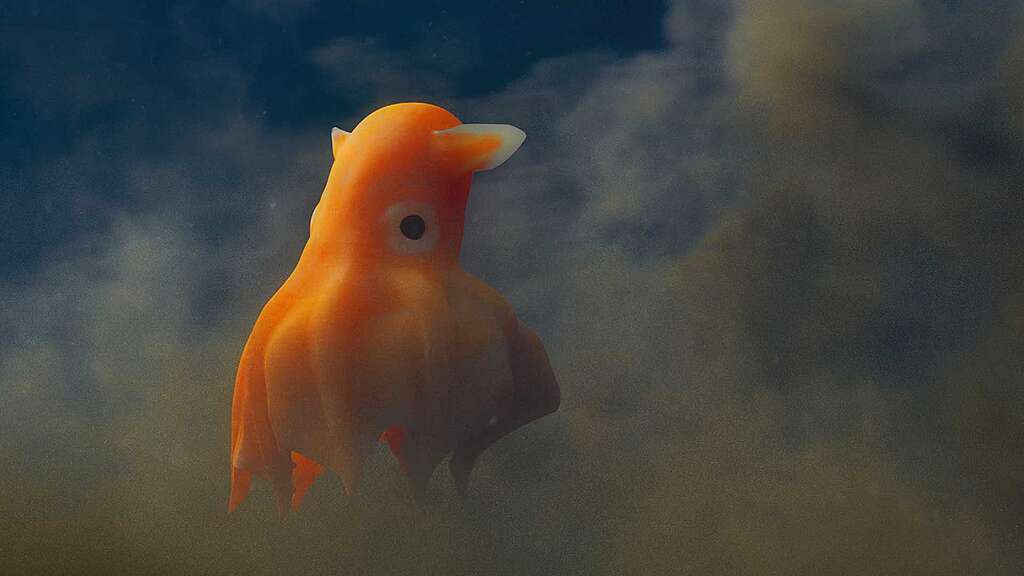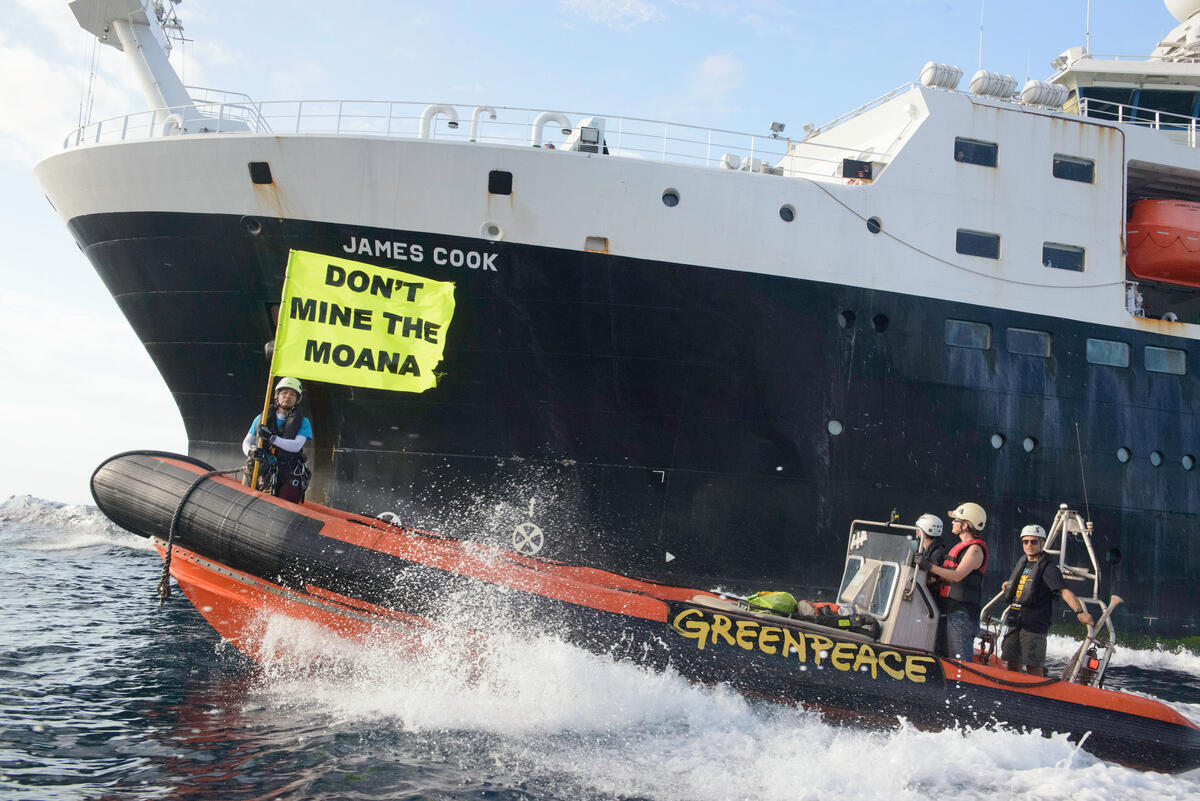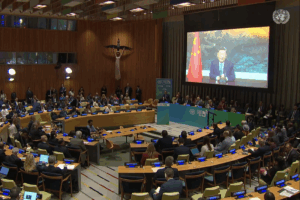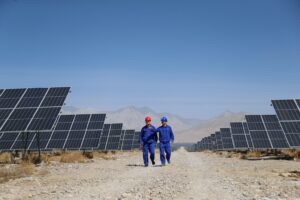Chinese president Xi Jinping, in an unexpected video address at the UN, announced last week that China will aim to cut greenhouse gas emissions 7-10% below peak levels by 2035.
The target was one of several new pledges that will be included in China’s 2035 nationally determined contribution (NDC), which China has yet to reveal in full.
Carbon Brief has published a detailed analysis of the announcement.
Yesterday, Carbon Brief hosted a webinar with China climate policy experts to discuss their assessments of what the NDC means for China’s emissions pathway, whether China will issue ambitious climate policies in the future and how it will affect global efforts to accelerate the energy transition.
The webinar was moderated by Carbon Brief’s deputy editor and senior policy editor Simon Evans and featured:
- Li Shuo, director of the China Climate Hub at the Asia Society Policy Institute
- Lauri Myllyvirta, lead analyst and co-founder at the Centre for Research on Energy and Clean Air
- Ryna Cui, associate director and associate research professor at the University of Maryland Center for Global Sustainability
- Anika Patel, Carbon Brief’s China analyst
The post Webinar: Experts discuss what China’s new climate pledge means for the world appeared first on Carbon Brief.
Webinar: Experts discuss what China’s new climate pledge means for the world
Climate Change
Close Major Deforestation Loopholes in the EPBC Act
22 October 2025
The Hon Anthony Albanese MP
Prime Minister
Parliament House
CANBERRA ACT 2600
Sent via email
To the Prime Minister, Federal Environment Minister, and Members of the Albanese Government,
As researchers who study, document and work to recover Australia’s plants and animals, insects and ecosystems, we are keenly aware of the value of nature to Australians and the world.
Australia has one of the worst rates of deforestation globally. For every 100 hectares of native woodland cleared, about 2000 birds, 15,000 reptiles and 500 native mammals will die. As scientists and experts, we have sounded the alarm for more than 30 years that the large-scale destruction of native woodlands, forests, wetlands and grasslands was the single biggest threat to the nation’s biodiversity. That is still the case today, and it is driving an extinction crisis.
New figures show that Queensland continues to lead the nation in deforestation. The latest statewide landcover and trees study (SLATS) report shows that annually 44% of all deforestation in Queensland occurs in the Great Barrier Reef catchment areas, where over 140,000 hectares are bulldozed each year.
Deforestation in Great Barrier Reef catchments is devastating one of Australia’s most iconic natural wonders. When forests and bushland are bulldozed, erosion causes debris to wash into waterways, sending sediment, nutrients and pesticides into the Reef waters. This smothers coral, fuels crown-of-thorns starfish outbreaks, and reduces water quality. These impacts compound the damage caused by repeated mass bleaching events driven by climate change.
The Great Barrier Reef sustains precious marine life, supports local and global biodiversity, and underpins tourism economies and coastal communities that rely on its survival. Continued mass deforestation threatens these values and could jeopardise the Reef’s World Heritage status. In 2026 the World Heritage Committee will review Australia’s progress in protecting the Reef and may consider placing it on the World Heritage in Danger list, if key threats to the Reef, including deforestation, are not addressed.
This mass deforestation happens due to a loophole in the Environment Protection and Biodiversity Conservation (EPBC) Act, our national nature law. Exemptions allow deforestation to continue largely unregulated by the EPBC Act through a grandfathering clause from 2000 known as “continuous use”. Without meaningful reform, deforestation will continue to drive massive biodiversity loss. This loophole must be closed as part of the proposed EPBC Act reforms. The law is meant to safeguard our wildlife and our most precious places like the Great Barrier Reef. Please support closing major deforestation loopholes in the EPBC Act as an urgent and priority issue for the Federal Government.
Sincerely,
Professor James Watson, University of Queensland
Dr. Michelle Ward
Mandy Cheung
Mr Lachlan Cross
Timothy Ravasi
Gillian Rowan
Dr Graham R. Fulton, The University of Queensland
Dr Alison Peel
Dr James Richardson University of Queensland
Luke Emerson, University of Newcastle
Dr Hilary Pearl
Dr Tina Parkhurst
Dr Kerry Bridle
Dr Tracy Schultz, Senior Research Fellow, University of Queensland
Dr. Zachary Amir
Prof David M Watson, Gulbali Institute, CSU
Naomi Ploos van Amstel, PhD candidate
David Schoeman
Associate Professor Simone Blomberg, University of Queensland
Professor Euan Ritchie, Deakin University
Dr Ian Baird, Conservation Biologist
Paul Elton (ANU)
Melissa Billington
Hayden de Villiers
Professor Brett Murphy, Charles Darwin University
Professor Sarah Bekessy
Professor Anthony J. Richardson (University of Queensland)
Prof. Winnifred Louis, University of Queensland
Dr Yung En Chee, The University of Melbourne
Dr Jed Calvert, postdoctoral research fellow in wetland ecology, University of Queensland
A/Prof Daniel C Dunn, Centre for Biodiversity and Conservation Science, University of Queensland
Lincoln Kern, Ecologist
Professor Corey Bradshaw, Flinders University
Dr. Viviana Gonzalez, The University of Queensland
Prof. Helen Bostock
Dr Leslie Roberson
Bethany Kiss
Assoc. Prof Diana Fisher, UQ, and co-chair of the IUCN Marsupial and Monotreme Specialist Group
Dr Jacinta Humphrey, RMIT University
Professor Mathew Crowther
Christopher R. Dickman, Professor Emeritus, The University of Sydney
Fiona Hoegh-Guldberg, RMIT University
Dr Bertram Jenkins
Dr Daniela ParraFaundes
Dr Jessica Walsh
Dr. GABRIELLA scata – marine biologist, wildlife protector
Katherine Robertson
Professor Jane Williamson, Macquarie University
William F. Laurance, Distinguished Professor, James Cook University
A/Prof Deb Bower
Dr Leslie Roberson, University of Queensland
Ms Jasmine Hall, Senior Research Assistant in Coastal Wetland Biogeochemistry, Ecology and Management, Australian Rivers Institute, Griffith University
Dr Kita Ashman, Adjunct Research Associate, Charles Sturt University
Genevieve Newey
Matt Hayward
Jessie Moyses
Natalya Maitz, PhD Candidate, The University of Queensland
Christina Ritchie
Liana van Woesik, PhD Student, University of Queensland
Benjamin Lucas, PhD Researcher
A/Prof. Carissa Klein, The University of Queensland
Conrad Pratt, PhD Student, University of Queensland
Dr Ascelin Gordon, RMIT University
Professor Nicole Graham, The University of Sydney
Professor Murray Lee, University of Sydney Law School
Dr Tracy Schultz, Snr Research Fellow, University of Queensland
Libby Newton (PhD candidate, Sydney Law School)
Hannah Thomas, University of Queensland
Professor Richard Kingsford, Director of the Centre for Ecosystem Science, UNSW Sydney
Dr Anna Hopkins
Lena van Swinderen, PhD candidate at the University of Queensland
Professor Jodie Rummer, James Cook University
Dr Nita Lauren, Lecturer, RMIT University
Dr Christina Zdenek
Madeline Davey
Dr Rachel Killean, Sydney Law School
Dr. Sofía López-Cubillos
Dr Claire Larroux
Dr Alice Twomey, The University of Queensland
Zoe Gralton
Dr Robyn Gulliver
Ryan Borrett, Murdoch University
Adjunct Prof. Paul Lawrence, Griffith University, Brisbane Qld
Professor Susan Park, University of Sydney
Dr Holly Kirk, Curtin University
Deakin Distinguished Professor Marcel Klaassen
Dr Megan Evans, UNSW Canberra
Dr Amanda Irwin, The University of Sydney
Dr Keith Cardwell
Professor Don Driscoll, Deakin University
Susan Bengtson Nash
Distinguished Professor David Lindenmayer
Dr Madelyn Mangan, University of Queensland
Dr Isabella Smith
Geoff Lockwood
Dr Paula Peeters, Paperbark Writer
Prof Cynthia Riginos, University of Queensland
Dr. Sankar Subramanian
Associate Professor Zoe Richards
Dr Jessie Wells, The University of Melbourne
Professor Gretta Pecl AM, University of Tasmania
Dr April Reside, The University of Queensland
Oriana Licul-Milevoj (Ecologist)
Dr Yves-Marie Bozec, University of Queensland
Dr Julia Hazel
Dr Judit K. Szabo
Ana Ulloa
Dr Andreas Dietzel
Philip Spark – North West Ecological Services
Jonathan Freeman
Dr/ Mohamed Mohamed Rashad
Climate Change
The Ocean We’re Still Discovering
The recent discovery of Grimpoteuthis feitiana, a new species of Dumbo octopus found deep in the Pacific, is a reminder of something both humbling and urgent: we still know so little about the ocean that shapes our lives. This fragile, finned creature, gliding silently more than a kilometer beneath the waves, has lived in these waters long before we mapped them, and its story is only now coming to light.

What moves me most about this discovery is not just the Dumbo octopus itself, but how it bridges science and culture. Its name draws inspiration from the flying apsaras of China’s Dunhuang murals, those graceful, winged figures that seem to dance through air and imagination. It reminds me that the deep sea has always held a place in our collective human story, — not only in myths and art, but in the ways we relate to nature, learn from it, and find meaning within it.
Pasifika connection to the ocean
For us in the Pacific, the ocean is more than a body of water. It is our identity, our culture, our history. Our ancestors read the seas to navigate, to survive, to connect communities scattered across islands. Discoveries like this Dumbo octopus awaken something deeper in me, — a sense that the ocean is alive with stories and wisdom we are only beginning to rediscover. And with that understanding comes a responsibility to protect it.

Each new species like the Dumbo octopus, each glimpse into the deep, is a warning as much as it is a wonder. The creatures of the abyss live slow, deliberate lives in fragile ecosystems, shaped by balance and patience. Deep-sea mining, pollution, and climate change threaten to erase them before we even learn their names. Protecting the Pacific’s oceans is not an abstract act of conservation; it is an act of cultural preservation, of love for our home, and for the unseen life that sustains us all.
Grimpoteuthis feitiana is more than a scientific discovery. It is a reminder that the ocean is still full of life, mystery, and wisdom — and that we have a duty to ensure these depths remain wild, healthy, and alive, for us and for the generations yet to come.
Reflection by Raeed Ali
Pacific Community Mobiliser
Climate Change
River of Life
Nature is not only mother to us all, but our shared witness. Because truly, we are never alone when in the hallowed company of the elements, and life of the earth.
Sometimes, it is the immensity of things which reaches inside you—oceans, sky and sun, or the curve of the terrestrial distance—while at other moments it is the intensity of intimate association at a smaller scale, like a single tree you know as a friend, or a specific combination of scent, stone, water and light, felt uniquely in situ.
In both great and small manifestations, the natural world solemnly and playfully attends our lives as we go about our business on this, our singular living planet.
I felt this sense of nature incarnated as an attentive companion acutely this week, when walking between meetings along the Swan River.
If you grow up in Perth, even in one of the outer suburbs as I did, the Swan River, or Derbal Yerrigan in the language of the Whadjuk Noongar People, is always there as a presence.
The bits I know best feel like a kind of emotional map of the journey through the years, as evocative as any diary. This patch, where I threw a cricket ball around with my best mate in the early evening, laughing at the joy of being alive as the spinning pill arced against the twilight; that slight bend in the path, imprinted with the ambivalent tension of being about to sit university exams; there, the site years ago, of running around at the feet of my Dad, as young as I can remember him; here, a spot that summons the sense of exhausting exhilaration when fecklessly going for a run in the mid-day western heat; and above all that cherished place, I will always associate with love, newly declared and found to be returned.
And other things too, inchoate layers of pleating fragments; thoughts and feelings without number, that will always be evoked in my mind by the sweep of the Swan
What is most evocative or sacred to us is always bound to feeling, rather than the product of any rational calculus. It is also true, though, that geography as memory is complicated by change—something that is a constant in nature; wildly accelerated by human intervention; and now spiralling into the violently unpredictable, because of global heating.
Derbal Yerrigan has no doubt always been changing, in the countless days that the river has flowed since time immemorial; but never altered or transformed in the way has occured since colonisation and industrialisation; nor in the way that is happening now.
I troubled about this while making my way along the Swan this week, and watched as an Australasian darter (Anhinga novaehollandiae) perched on the river wall and spread its wings interstitially, as if gesturing to signify the bonds between the land, water and sky. At that moment, I abruptly remembered that my gaze was not solitary, because far and high in the air behind me were the lidless eyes of the city skyscrapers, including the dark towers of the fossil fuel giants, Woodside and Chevron, staring down with abject contempt for the future.
I suspect like many of us, I feel a perpetual mental struggle between the dissonance of the everyday, which, even despite spring temperatures soaring 15 degrees Celsius above average, still has a normalcy to it that is discordant with what we know about the realities of global warming, and the forecasts of what is to come. The Swan, like all rivers, now faces its most violent test yet of rising temperatures and extreme unnatural events.
The attendance of nature to our lives is not passive. If we think only of ‘the environment’ just as subject, we miss the point of both our own embeddedness in this world, and of the agency of life itself. Every species on earth has an innate energy to flourish and reproduce. The Swan River will keep on rolling, with all of the intense hydrological power at its command. Given half a chance nature will resurge and rebound in wood and feather, tooth and maw.
Our conscious task, I think to myself, but mentally addressing both the bird and the river, is to purposefully draw on the power of this meaning; an internal strength derived from the preciousness of our memories imbricated in place.
I pause and offer a silent pledge to the River: you’ve always been there for us. And in the activism, ingenuity, campaigning and commitment of millions of determined people across Australia and the world, all of whom are dedicated to stopping the destruction of nature and the climate and of securing a return to flourishing, so we will be there for you.

Q & A
Greenpeace campaigns are always solution-led, and one of the questions I have been asked a lot over the years is about our systemic solution for Western Australia to reduce emissions at an emergency speed and scale, and get off gas.
This week, it was terrific to be in Perth, joining colleagues to help launch a comprehensive decarbonisation plan for the state, Power Shift: WA’s Electrified Future written in collaboration with Springmount Advisory.
This report comprehensively shows how WA’s economy can be aligned with the global goal of limiting warming to 1.5°C, and breaks down the transition pathway WA can take across energy, industry, transport and agriculture to achieve this. It highlights the challenges and opportunities across each sector, and provides policy level solutions to achieve these ambitions using only already-existing technologies. You can check out the report here.
-
Climate Change2 years ago
Spanish-language misinformation on renewable energy spreads online, report shows
-
Climate Change3 months ago
Guest post: Why China is still building new coal – and when it might stop
-
Climate Change Videos2 years ago
The toxic gas flares fuelling Nigeria’s climate change – BBC News
-

 Greenhouse Gases1 year ago
Greenhouse Gases1 year ago嘉宾来稿:满足中国增长的用电需求 光伏加储能“比新建煤电更实惠”
-
Greenhouse Gases3 months ago
Guest post: Why China is still building new coal – and when it might stop
-

 Climate Change1 year ago
Climate Change1 year ago嘉宾来稿:满足中国增长的用电需求 光伏加储能“比新建煤电更实惠”
-

 Carbon Footprint2 years ago
Carbon Footprint2 years agoUS SEC’s Climate Disclosure Rules Spur Renewed Interest in Carbon Credits
-
Renewable Energy3 months ago
US Grid Strain, Possible Allete Sale








